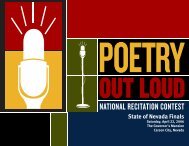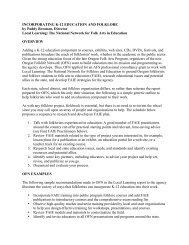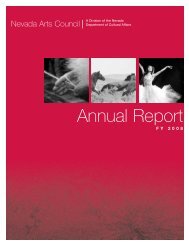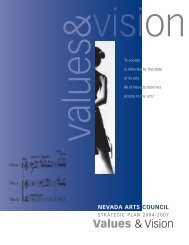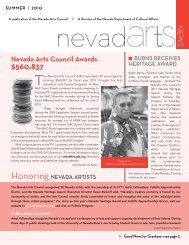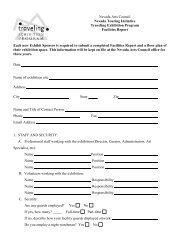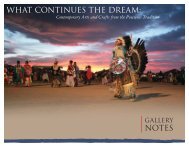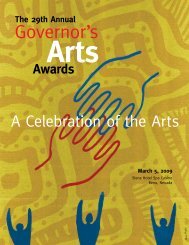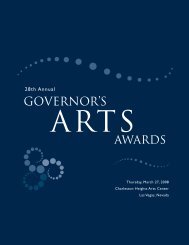Public Art - Nevada Arts Council
Public Art - Nevada Arts Council
Public Art - Nevada Arts Council
You also want an ePaper? Increase the reach of your titles
YUMPU automatically turns print PDFs into web optimized ePapers that Google loves.
2 | Monograph | March 2004<br />
Number and Type of <strong>Public</strong> <strong>Art</strong> Programs<br />
Today, there are more than 350 public art<br />
programs that support thousands of artists’<br />
projects in airports, train stations, libraries, parks,<br />
streetscapes, government buildings, and<br />
neighborhoods—urban, suburban, and rural. The<br />
majority of public art programs (81 percent) are<br />
housed within a public agency—an office of<br />
cultural affairs, arts commission, or some other<br />
operating department. Most programs involve<br />
volunteer commissioners and committee members<br />
in addition to a significant amount of staff time.<br />
Many programs also contract with outside<br />
vendors, such as planning consultants,<br />
conservators, public relations specialists, Web<br />
designers, writers, researchers, and photographers.<br />
Some programs have begun to hire artists to serve<br />
on design teams and participate in city planning<br />
or use artist-in-residence strategies to engage<br />
communities in the process.<br />
In October 2003, the <strong>Public</strong> <strong>Art</strong> Network<br />
released the first comprehensive, national<br />
survey of public art programs in the United<br />
States. The survey studied budgets, funding<br />
sources, program administration, and how<br />
programs work with artists. The resulting survey<br />
report, <strong>Public</strong> <strong>Art</strong> Programs Fiscal Year 2001:<br />
A Detailed Statistical Report on the Nation’s<br />
<strong>Public</strong> <strong>Art</strong> Programs, is the source for the<br />
public art program information found in this<br />
Monograph. A copy can be ordered from<br />
the Americans for the <strong>Art</strong>s bookstore at<br />
Adams Street Bridge, Longfellow Creek<br />
Habitat Improvement Project, Lorna Jordan,<br />
artist. Photo courtesy of City of Seattle<br />
Office of <strong>Art</strong>s & Cultural Affairs.<br />
A majority of programs either commission or<br />
purchase permanent works of art, such as<br />
sculptures, murals, mosaics, decorative features,<br />
or functional elements. These are typically<br />
viewed as enhancements, contributing to public<br />
improvement or civic construction projects.<br />
Leading programs, such as that of Seattle’s Office<br />
of <strong>Art</strong>s & Cultural Affairs, have sought strategies<br />
to offer more diverse public programming and<br />
artist services, including exhibitions; educational<br />
workshops; slide registries; and sophisticated,<br />
interactive websites.<br />
Private nonprofit organizations, such as the<br />
Tucson Pima (AZ) <strong>Art</strong>s <strong>Council</strong> and the<br />
Regional <strong>Art</strong>s and Culture <strong>Council</strong> in Portland,<br />
OR, also operate public art programs as part of a<br />
larger set of programs and services. A select few,<br />
such as Creative Time and the <strong>Public</strong> <strong>Art</strong> Fund<br />
in New York City, operate independently. The<br />
flexibility of these programs usually results in a<br />
greater diversity of activities, from emerging<br />
artist programs and temporary installations to<br />
community events and educational offerings.<br />
www.AmericansForThe<strong>Art</strong>s.org.<br />
www.AmericansForThe<strong>Art</strong>s.org



